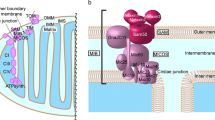Abstract
Previous studies of the rate constants for the elementary steps of ATP hydrolysis by the soluble and membrane-bound forms of beef heart mitochondrial F1 supported the proposal that ATP is formed in high-affinity catalytic sites of the enzyme with little or no change in free energy and that the major requirement for energy in oxidative phosphorylation is for the release of product ATP.
The affinity of the membrane-bound enzyme for ATP during NADH oxidation was calculated from the ratio of the rate constants for the forward binding step (k +1) and the reverse dissociation step (k −1).k −1 was accelerated several orders of magnitude by NADH oxidation. In the presence of NADH and ADP an additional enhancement ofk −1 was observed. These energy-dependent dissociations of ATP were sensitive to the uncoupler FCCP.k +1 was affected little by NADH oxidation. The dissociation constant (K d ATP) increased many orders of magnitude during the transition from nonenergized to energized states.
Similar content being viewed by others
References
Al Shawi, M. K., and Senior, A. E. (1988).J. Biol. Chem. 263 19640–19648.
Bragg, P. D., Davies, P. L., and Hou, C. (1973).Arch. Biochem. Biophys. 159 664–671.
Boyer, P. D. (1993).Biochim. Biophys. Acta 1140 215–250.
Boyer, P. D., Cross, R. L., and Momsen, W. (1973).Proc. Natl. Acad. Sci. USA 70 2837–2839.
Cross, R. L., Grubmeyer, C., and Penefsky, H. S. (1982).J. Biol. Chem. 257 12101–12105.
Cunningham, D., and Cross, R. L. (1988).J. Biol. Chem. 263 18850–18856.
Engelbrecht, S., and Junge, W. (1990).Biochim. Biophys. Acta 1015 379–390.
Futai, M., Sternweiss, P. C., and Heppel, L. A. (1974).Proc. Natl. Acad. Sci. USA 71 2725–2729.
Graber, P., Fromme, P., Junesch, U., Schmidt, G., and Thulk, G. (1986).Ber. Bunsenges. Phys. Chem. 90 1034–1040.
Grubmeyer, C., and Penefksy, H. S. (1981a).J. Biol. Chem. 256 3718–3727.
Grubmeyer, C., and Penefsky, H. S. (1981b).J. Biol. Chem. 256 3728–3734.
Grubmeyer, C., Cross, R. L., and Penefsky, H. S. (1982).J. Biol. Chem. 257 12092–12100.
Hisabori, T., Muneguki, E., Odaka, M., Yokoyama, K., Mochizuki, K., and Yoshida, M. (1992).J. Biol. Chem. 267 4551–4556.
Jencks, W. P. (1975).Adv. Enzymol. 43 219–410.
Jencks, W. P. (1989).Methods Enzymol. 171 145–164.
Kayalar, C., Rosing, J., and Boyer, P. D. (1977).J. Biol. Chem. 252 2486–2491.
Matsuno-Yagi, A., and Hatefi, Y. (1985).J. Biol. Chem. 260 14424–14427.
Mendel-Hartvig, J., and Capaldi, R. A. (1991).Biochim. Biophys. Acta 1060 115–124.
Mitchell, P. (1961).Nature (London)191 144–148.
Mueller, D. M. (1989).J. Biol. Chem. 264 16552–16556.
Noumi, T., Taniai, M., Kanazawa, H., and Futai, M. (1986).J. Biol. Chem. 261 9196–9201.
Penefsky, H. S. (1985a).J. Biol. Chem. 260 13728–13734.
Penefsky, H. S. (1985b).J. Biol. Chem. 260 13735–13741.
Penefsky, H. S. (1985c).Proc. Natl. Acad. Sci. USA 82 1589–1593.
Penefsky, H. S. (1986).Methods Enzymol. 126 608–618.
Penefsky, H. S., and Cross, R. L. (1991).Adv. Enzymol. Relat. Areas Mol. Biol. 64 173–214.
Rosing, J., Kayalar, C., and Boyer, P. D. (1977).J. Biol. Chem. 252 2478–2485.
Souid, A. K., and Penefsky, H. S. (1994). Unpublished observations.
Sternweis, P. C., and Smith, J. B. (1977).Biochemistry 16 4020–4025.
Xiao, R., and Penefsky, H. S. (1994).J. Biol. Chem., in press.
Yohda, M., and Yoshida, M. (1987).J. Biochem. 269 4233–4239.
Author information
Authors and Affiliations
Rights and permissions
About this article
Cite this article
Souid, A.K., Penefsky, H.S. Mechanism of ATP synthesis by mitochondrial ATP synthase from beef heart. J Bioenerg Biomembr 26, 627–630 (1994). https://doi.org/10.1007/BF00831537
Received:
Issue Date:
DOI: https://doi.org/10.1007/BF00831537




